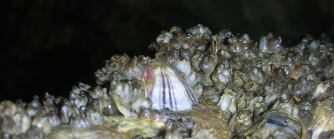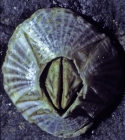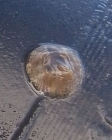
| Intro | | Search taxa | | Browse taxa | | Distributions | | Terminology | | References | | Statistics | | Online sources | | Tutorial | | Log in |
WoRMS taxon detailsAmphibalanus amphitrite (Darwin, 1854)
421137 (urn:lsid:marinespecies.org:taxname:421137)
accepted
Species
Balanus amphitrite Darwin, 1854 · unaccepted
marine
(of Balanus amphitrite Darwin, 1854) Darwin, C. (1854). A Monograph on the Sub-Class Cirripedia with Figures of All the Species. The Balanidae, (or Sessile Cirripedia); the Verricidae, etc., etc., etc. <em>The Ray Society, London.</em> i-viii + 1-684, pls. 1-30., available online at https://ia600409.us.archive.org/30/items/monographonsubcl02darw/monographonsubcl02darw.pdf
page(s): 240 [details]
WoRMS (2024). Amphibalanus amphitrite (Darwin, 1854). Accessed at: https://www.marinespecies.org/aphia.php?p=taxdetails&id=421137 on 2024-07-27
original description
(of Balanus amphitrite Darwin, 1854) Darwin, C. (1854). A Monograph on the Sub-Class Cirripedia with Figures of All the Species. The Balanidae, (or Sessile Cirripedia); the Verricidae, etc., etc., etc. <em>The Ray Society, London.</em> i-viii + 1-684, pls. 1-30., available online at https://ia600409.us.archive.org/30/items/monographonsubcl02darw/monographonsubcl02darw.pdf
page(s): 240 [details] context source (Introduced species) Fofonoff, P.W.; Ruiz, G.M.; Steves, B.; Carlton, J.T. (2014). National Exotic Marine and Estuarine Species Information System (NEMESIS), available online at http://invasions.si.edu/nemesis [details] context source (Deepsea) Intergovernmental Oceanographic Commission (IOC) of UNESCO. The Ocean Biogeographic Information System (OBIS), available online at http://www.iobis.org/ [details] context source (HKRMS) Blackmore, G.; Rainbow, P. S. (2000). Barnacles as biomonitors of trace metal availabilities in Hong Kong coastal waters 1998 update. <em>In: Morton B, editor. Proceedings of the Tenth International Marine Biological Workshop: The Marine Flora and Fauna of Hong Kong and Southern China. The marine flora and fauna of Hong Kong and southern China V. Hong Kong University Press, Hong Kong.</em> 385-409. [details] additional source Webber, W.R., G.D. Fenwick, J.M. Bradford-Grieve, S.G. Eagar, J.S. Buckeridge, G.C.B. Poore, E.W. Dawson, L. Watling, J.B. Jones, J.B.J. Wells, N.L. Bruce, S.T. Ahyong, K. Larsen, M.A. Chapman, J. Olesen, J.S. Ho, J.D. Green, R.J. Shiel, C.E.F. Rocha, A. Lörz, G.J. Bird & W.A. Charleston. (2010). Phylum Arthropoda Subphylum Crustacea: shrimps, crabs, lobsters, barnacles, slaters, and kin. <em>in: Gordon, D.P. (Ed.) (2010). New Zealand inventory of biodiversity: 2. Kingdom Animalia: Chaetognatha, Ecdysozoa, Ichnofossils.</em> pp. 98-232 (COPEPODS 21 pp.). [details] Available for editors additional source Liu, J.Y. [Ruiyu] (ed.). (2008). Checklist of marine biota of China seas. <em>China Science Press.</em> 1267 pp. (look up in IMIS) [details] Available for editors additional source Lutaenko, K.A.; Furota, T.; Nakayama; S.; Shin, K.; Xu, J. (2013). Atlas of Marine Invasive Species in the NOWPAP Region. Beijing: NOWPAP DINRAC (Northwest Pacific Action Plan, Data and Information Network Regional Center). 189 pp. [details] biology source Tepolt, C. K. (2014). Adaptation in marine invasion: a genetic perspective. <em>Biological Invasions.</em> 17(3): 887-903., available online at https://doi.org/10.1007/s10530-014-0825-8 note: Here, I review evidence for adaptation in marine invasion, considering both quantitative and genetic studies. [details] Available for editors  Present Present  Present in aphia/obis/gbif/idigbio Present in aphia/obis/gbif/idigbio  Inaccurate Inaccurate  Introduced: alien Introduced: alien  Containing type locality Containing type locality
From regional or thematic species database
Introduced species abundance in Gulf of Mexico (IHO Sea Area) : This could represent an isolated specimen collected from a ship. [details]Introduced species abundance in Jamaican part of the Caribbean Sea : Southward (1975) and Bacon (1976) found it rare and local in Jamaica. [details] Introduced species abundance Panamanian part of the Caribbean Sea (Marine Region) : abundant [details] Introduced species abundance in Trinidad and Tobago part of the Caribbean Sea (Marine Region): Southward (1975) and Bacon (1976) found it largely confined to ships and man-made structures in Bonaire and Trinidad. [details] Introduced species abundance in United States part of the North Atlantic Ocean (Marine Region) : abundant on the West coast [details] Introduced species impact Japanese part of the Philippine Sea (Marine Region) : Loss of aquaculture/commercial/recreational harvest or gain [details] Introduced species impact Japanese part of the Philippine Sea (Marine Region) : Water abstraction or nuisance fouling [details] Introduced species impact in United States part of the North Atlantic Ocean (Marine Region) : Water abstraction or nuisance fouling [details] Introduced species impact Chinese part of the Yellow Sea (Marine Region) Water abstraction or nuisance fouling [details] Introduced species impact Chinese part of the Eastern Chinese Sea(Marine Region) Water abstraction or nuisance fouling [details] Introduced species impact Chinese part of the South China Sea (Marine Region) Water abstraction or nuisance fouling [details] Introduced species remark Japanese part of the Philippine Sea (Marine Region) : Amphibalanus amphitrite is reported to foul 'sluice systems' in Japan (Chavanich et al. 2010). [details] Introduced species remark In United States part of the North Atlantic Ocean (Marine Region) : A. amphitrite is one of the most abundant fouling barnacles in warmer harbors of the U.S. (Moore and Frue 1959; Carlton 1979), and worldwide (Zevina 1988; Jones 1992; Shkedy et al. 1995) [details] Introduced species vector dispersal in Belgian part of the North Sea: Ships: accidental as attached or free-living fouling organisms [details] Introduced species vector dispersal Chinese part of the Yellow Sea (Marine Region) Ships: General [details] Introduced species vector dispersal Chinese part of the Eastern Chinese Sea(Marine Region) Ships: General [details] Introduced species vector dispersal Chinese part of the South China Sea (Marine Region) Ships: General [details] From other sources
Alien species The striped barnacle Amphibalanus amphitrite is a cosmopolitan barnacle that naturally occurs in almost every tropical and subtropical sea. It is a typical fouling species that can reach different places by attaching itself to ship’s hulls. The first specimen in Belgium was found in 1952 in farmed oysters in the port of Ostend. It took till February 1995 till the striped barnacle was commonly found along the Belgian coast. It was thought that the cold winter temperatures would kill off the species in the Belgian regions, but this did not happen. The barnacle today (2011) is a common inhabitant in the port of Ostend. The species thrives well in areas with a certain degree of physical stress or pollution. [details]
Guide to the exotic species of San Francisco bay - Balanus amphitrite (from synonym Balanus amphitrite Darwin, 1854)
To Barcode of Life (166 barcodes) To Barcode of Life (6 barcodes) (from synonym Balanus amphitrite Darwin, 1854) To Biodiversity Heritage Library (1 publication) To Biodiversity Heritage Library (119 publications) (from synonym Balanus amphitrite Darwin, 1854) To Biological Information System for Marine Life (BISMaL) (from synonym Balanus amphitrite Darwin, 1854) To Biological Information System for Marine Life (BISMaL) To European Nucleotide Archive, ENA (Amphibalanus amphitrite) To GenBank (77129 nucleotides; 88283 proteins) To GenBank (77129 nucleotides; 88283 proteins) (from synonym Balanus amphitrite Darwin, 1854) To Global Biotic Interactions (GloBI) To Information system on Aquatic Non-Indigenous and Cryptogenic Species (AquaNIS) (from synonym Balanus amphitrite Darwin, 1854) To MNHN Fossil collection (Balanus amphitrite DARWIN, 1854; Figuré; F.R03681) (from synonym Balanus amphitrite Darwin, 1854) To Niet-inheemse soorten Belgisch deel Noordzee en aanpalende estuaria (in Dutch) To PESI To PESI (from synonym Balanus amphitrite Darwin, 1854) To USNM Invertebrate Zoology Arthropoda Collection (8 records) (from synonym Balanus amphitrite Darwin, 1854) To Yale Peabody Museum of Natural History (YPM IZ 063930) |





